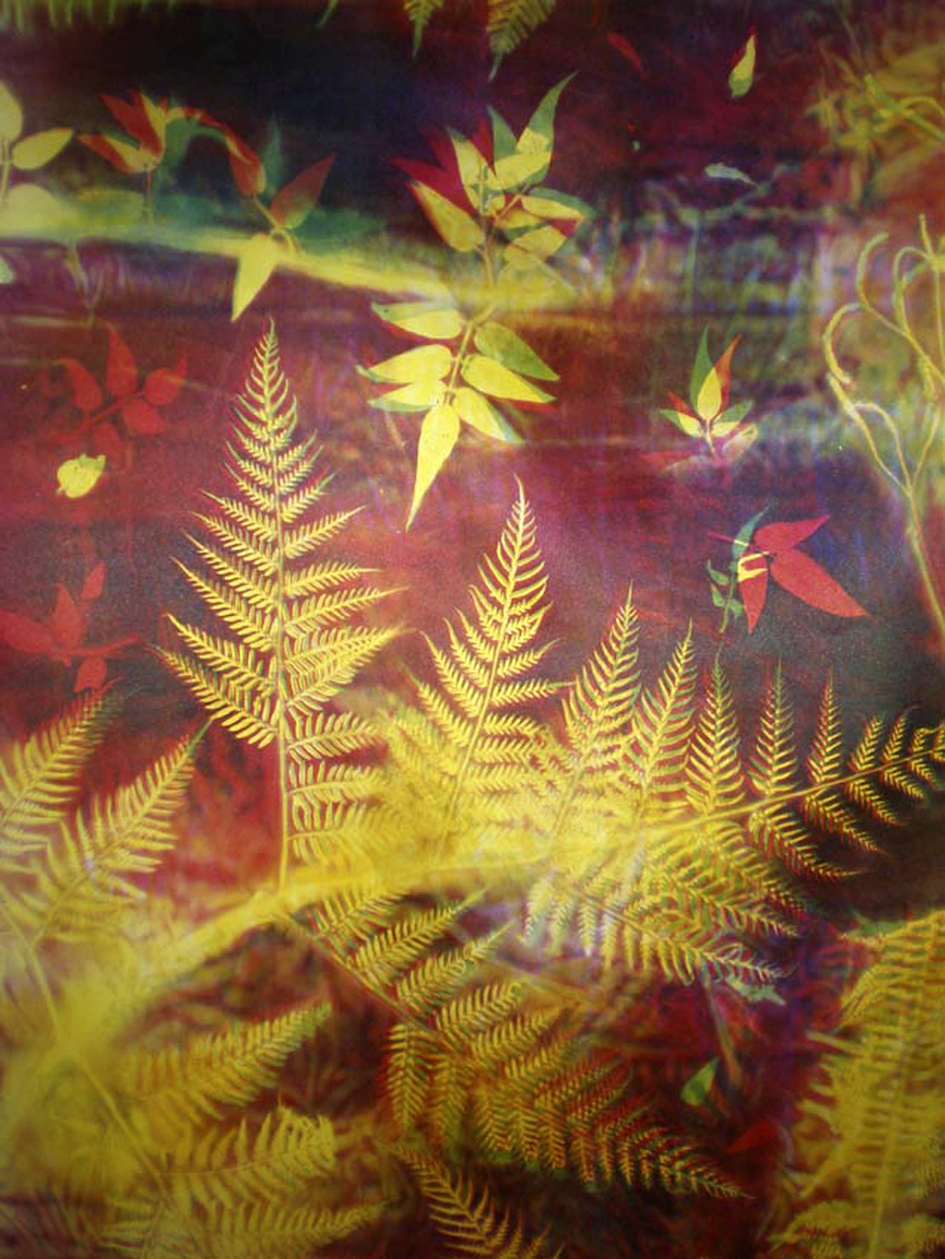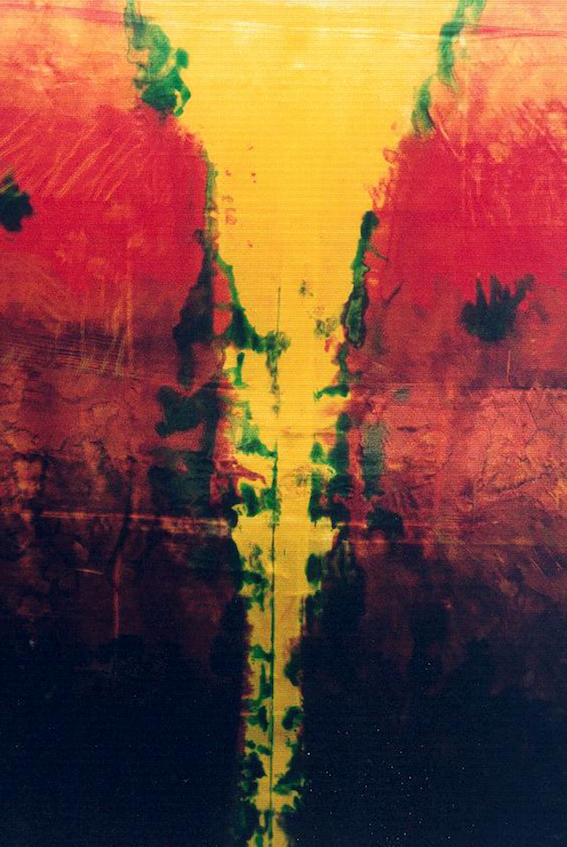
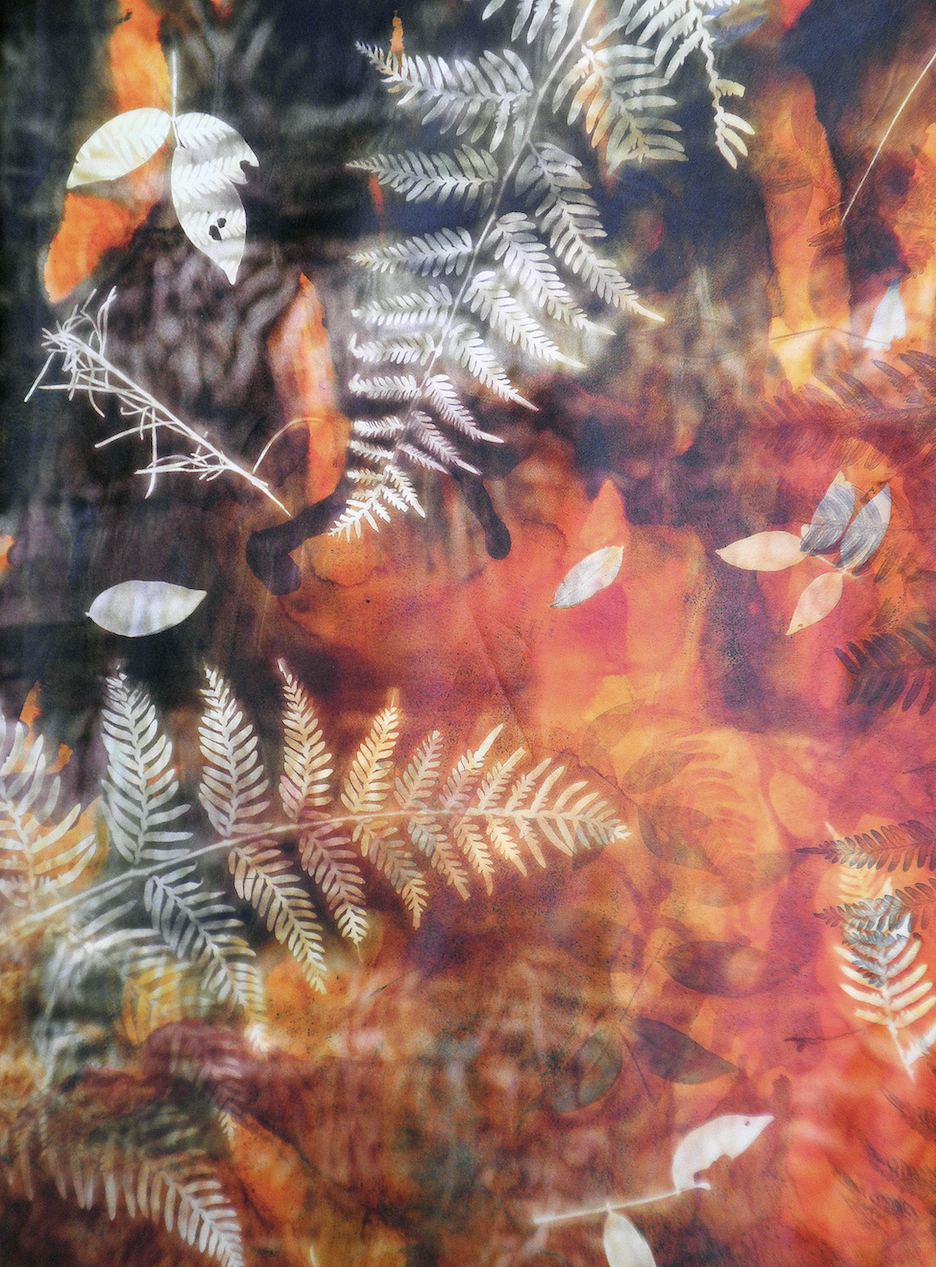
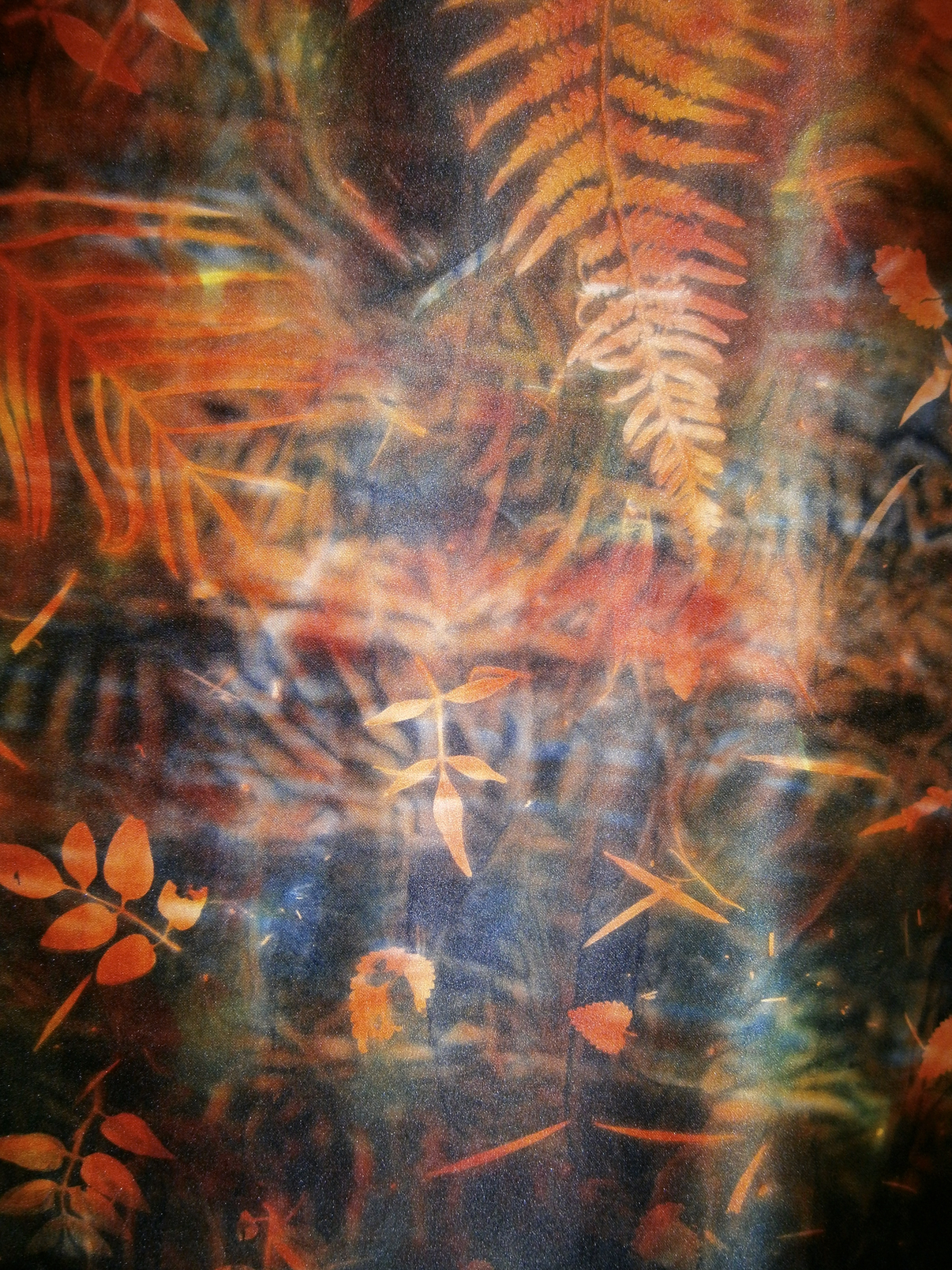
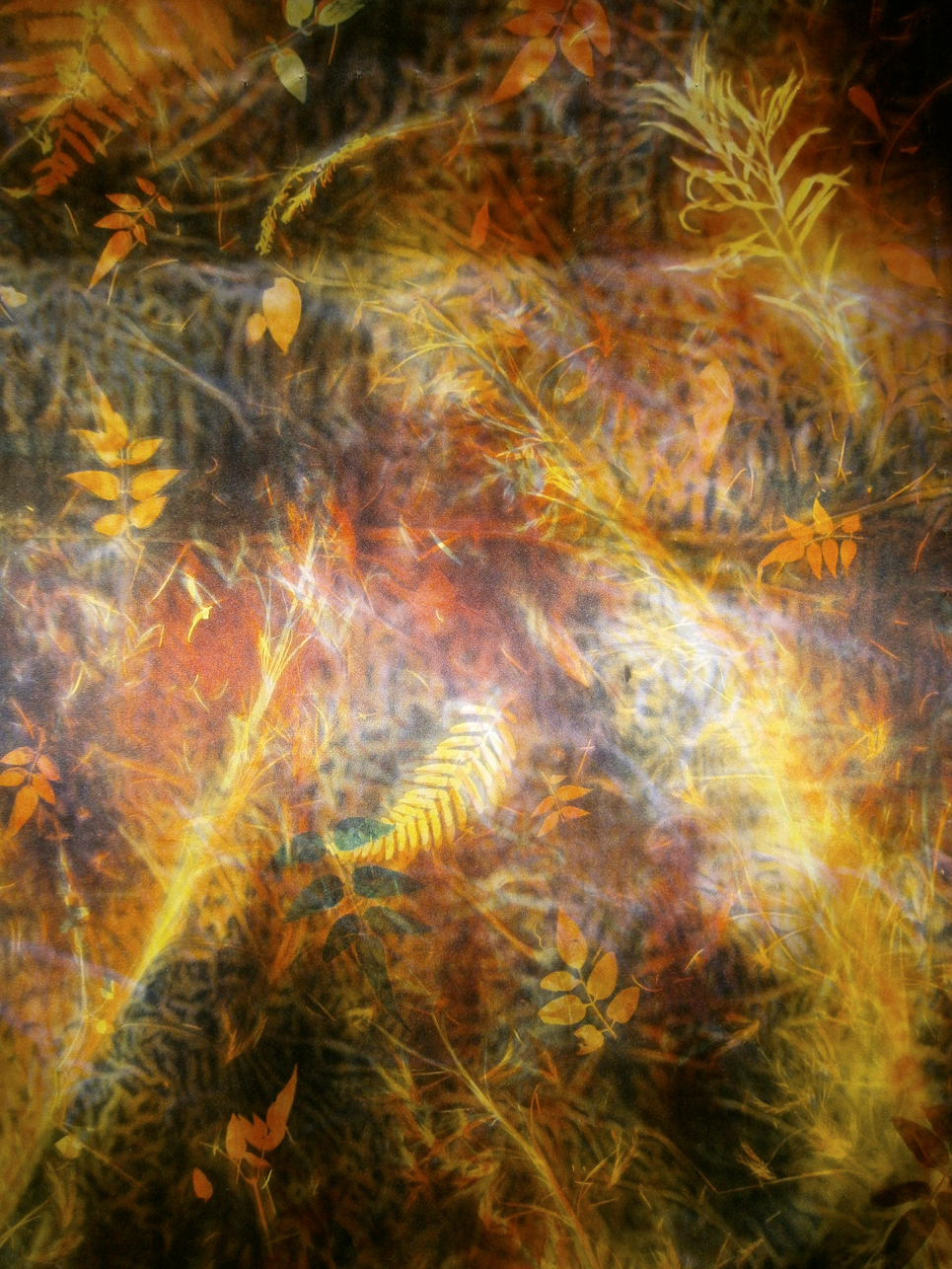
From top:
Marie-Therese Wisniowski:
Sequestration of CO2 (detail), 2009, MultiSperse Dye Sublimation (MSDS) technique employing disperse dyes, native flora and low relief items on synthetic satin, 30 x 60 cm
Autumn Bolt, 2005, hand-painted and heat transferred using disperse dyes on synthetic satin, 290 x 144 cm
Flames Unfurling (detail), 2014, MultiSperse Dye Sublimation (MSDS) technique employing disperse dyes, native flora and low relief items on synthetic satin, 120 x 60 cm
Black Saturday (detail), 2016, MultiSperse Dye Sublimation (MSDS) technique employing disperse dyes, native flora and low relief items on synthetic satin, 120 x 60 cm
Gondwana Retraced I (detail), 2016, MultiSperse Dye Sublimation (MSDS) technique employing disperse dyes, native flora and low relief items on synthetic satin, 120 x 60 cm
What were some of the foundation ideas for this exhibition project?
The 2015 Paris Agreement set a global goal to reach net zero greenhouse emissions in the second half of this century. An increasing number of governments are translating that into national strategy, setting out visions of a carbon-free future. More than a hundred countries have joined an alliance aiming for net zero emissions by 2050. Australia is not one of them!
The Earth’s population is spiralling out of control and is predicted to reach 9.8 billion people in 2050. Every religion on Earth has the uncontrolled birth of children at the core of its belief systems. In May 2021 China scrapped its previous two-child policy and will allow couples to have three children.
The need to shelter, clothe and feed the world’s population in 2050 will place substantial pressure on land clearage for food, building materials, the production of fibres and moreover, to house an ever-growing population.
The pressure on maintaining the natural flora and fauna across the world will be immense. Nature is declining globally at rates unprecedented in human history – and the rate of species extinctions is accelerating, with grave impacts on people around the world now likely.
The basis of my artwork over the past three decades has been to raise our consciousness to these environmental issues and confront what needs to be politically put in place to save our Australian flora and fauna.
How did the artwork selection take place?
My current work explores contemporary natural environmental landscapes. My world view is often framed through the eyes of the forgotten, the discarded, the marginalised or the misrepresented and so sits conceptually on socio-political boundaries. The ArtCloth I create relies heavily on research, discussion and moreover, on pondering holistically on the creation of the images and how they engage my conceptual awakening to the viewer. The philosophy underlying my ‘Environmental Art’ strives to prick the viewer’s consciousness to garner support for sustainability.
In the late 1990s I started to experiment with disperse dyes on polyester and synthetic fabrics using transfer printing techniques. I was captivated by the richness, depth of colour, and overprinting possibilities that could be achieved using the dyes. Since then, I have been experimenting with hand printing techniques using disperse dyes on synthetic and polyester fabrics. These experiments led to the development of my signature MultiSperse Dye Sublimation (MSDS) technique.
The MSDS technique uses disperse dyes and involves hand printing multiple resists, and multiple overprinted layers with numerous colour plates, low relief items and plant materials. The results are rich in colour, light, shade, contrast, movement and depth. The multiple layers imbue a painterly as well as textural aesthetic, yielding a three-dimensional quality. Each print is unique and cannot be replicated.
Every ArtCloth work in this exhibition centres on an aspect of anthropogenic climate change and the effect it will have on the existing Australian flora/landscape.
Artworks were also selected because of the available exhibition space. Rathmines Heritage Centre’s Boiler Room allowed for large ArtCloth works (1.5m w x 3m h) to be hung in a space to fill the three-dimensional size of the building, with smaller ArtCloth works being exhibited on the surrounding internal walls together with explanations of the techniques used and the subject matter of the artwork.
How does the exhibition manifest – what do visitors experience?
This exhibition installation is composed of two-dimensional ArtCloth works. During the act of engagement, visitors have a three-dimensional experience. To add to the three-dimensional experience, it is important that my large two-dimensional ArtCloth works dominate the volume of the exhibition space. Hence, they are hung from ceiling rafters in the central area of the building.
These 1.5m wide x 3m in height ArtCloth works dominate the size of the viewer and so the viewer must look up at them and in doing so feel dominated by the artwork. As these large artworks are hung in the volume of the exhibition space the viewer, during acts of engagement, must negotiate a pathway around each exhibited ArtCloth work in order to see the other hung works in the venue, giving the whole exhibition a three-dimensional rather than a two-dimensional experience.
During the act of engagement, the viewer experiences the effects of anthropogenic climate change on the flora/landscape. It is hoped that with the explanatory statement which is presented with each ArtCloth work, the viewer is moved to be more consciously proactive in protecting our existing flora and fauna.
What are some of the key works and what subject matter do they deal with?
The Australian landscape has been and will always be bedevilled by bushfires. To this day, the manner in which Australian biota has tolerated and then exploited bushfires for reproductive advantage is still not understood and so is a topic of debate. The ArtCloth work Flames Unfurling explores the destructive power of a drier world due to anthropogenic climate change.
The 2009 bushfires in January and February ravaged many parts of the state of Victoria and touched directly and indirectly many millions of people in the state, across Australia and internationally. The ArtCloth work Black Saturday depicts the devastation of this single catastrophic event.
What is it about the printmaking experience that you most appreciate?
The freedom it gives me, the artistic voice I can use for socio-political comment – to uncover the plights of the down-trodden and the biosphere that is under threat due to the predicted 9 billion humans roaming planet Earth. Other printmaking experiences include –
(i) Printmaking on paper or cloth is a most democratic art media since it requires little technical skills compared with other art media and practices.
(ii) There is a breadth and depth of teaching resources with respect to printmaking, which is readily available and moreover, reaches into urban and more importantly, into remote communities.
(iii) The equipment and pigments used for printmaking on paper or cloth can be cheap and readily available.
(iv) Printmaking on paper or cloth spans political commentary to fine-art traditions.
(v) Printmaking on paper is archival (when using non-acidic paper). In the case of ArtCloth, galleries are well versed in how textiles should be stored and maintained.
(vi) Printmaking on paper or cloth is easily replicated and so large editioned series can be generated.
(vii) Printmaking on paper and cloth is an activity that can involve a single person or a group of people.
—
Marie-Therese Wisniowski’s The Effects of Global Warming ArtCloth exhibition is at the Rathmines Heritage Centre, Boiler Room, 25 Stilling St., Rathmines, NSW, until 20 June
https://www.lakemac.com.au/Events-directory/Council-events/Dobell-Festival
—
Join the PCA and become a member. You’ll get the fine-art quarterly print magazine Imprint, free promotion of your exhibitions, discounts on art materials and a range of other exclusive benefits.

